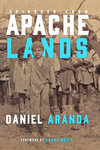Wind: mph,
Welcome to our new web site!
To give our readers a chance to experience all that our new website has to offer, we have made all content freely avaiable, through October 1, 2018.
During this time, print and digital subscribers will not need to log in to view our stories or e-editions.


By Jason K. Watkins
Las Cruces historian and writer Daniel Aranda has spent a lifetime researching the stories of the Southwest that make up his new book, “Episodes from Apache Lands,” available online and at local bookstores, and he has discovered new details about famous Apache warriors like Victorio and Josanie.
It has taken Aranda decades to finally publish his research, though, because he’s been busy doing other things. He spent his career as a firefighter and was once named Las Cruces’ Firefighter of the Year. He retired from NASA as an officer, and has worked as a caregiver for family members, yet still found time to research the rich and neglected history of the Southwest.
The results of his decades of study are 10 detailed chapters about important Apache leaders like Geronimo, famous battles, and forgotten figures. Among them are Santiago McKinn, a young American boy who was captured by Apaches. He was the only captive ever photographed while still in Indian captivity — the photograph appears on the cover of the book — and Aranda provides new details about his story through relatives and people who knew him.
Another chapter covers the famed warrior chief Josanie’s 1885 raid into the U.S. Aranda provides new evidence that the number of people killed in the raid was exaggerated.
Aranda has also written for True West, Real West, the Southern New Mexico HIstorical Review, Desert Tracks, and other magazines.
“Apache Lands” is available on newsstands and online now for less than $20.
“I have waited 36 years for a book by Dan,” writes Frank Brito in the foreword, “as distance does not allow me frequent access to his skill in relating a great story.”
Brito is the son of one of Teddy Roosevelt’s Rough Riders and served in World War II.
“Episodes from Apache Lands” was published by ECO Publishing, a small press in New Mexico’s Bootheel. Part of the Chiricahua Desert Museum, ECO focuses on regional history and science. The Desert Museum facility is a private campus that includes a botanical garden, event center, live reptiles, a gift shop, and lodging, all dedicated to preserving the natural history and human history of the Southwest.
Q&A
Apache Lands is a fast-paced, accessible book to read, but it’s also incredibly well researched. How long have you been working on it, and what kind of research did you do?
I have always been fascinated by the American Indian and with the nudging of Eve Ball and then later, by Dan Thrapp, Ed Sweeney, Lynda Sanchez, Keith Humphries, Lee Myers and many more, I decided to give it a try. I was in my twenties when I had my first article published by True West magazine and followed by other factual magazines and journals. I then had a long hiatus because of a workload and when I became a care-giver for many years before I could get back to what I had started. I have been to many depositories such as the National Archives, Huntington Library, Bancroft Library, Arizona Historical Society and many more universities. ‘Mom and Pop’ museums sometimes can surprise you with their collections. Also, in the early days, there were still people around who were not long removed from the events and were glad to contribute what they could. Newspapers can be used, but be very careful with them as they are notorious for exaggerating or reporting erroneous news. They are useful anyway for many other reasons such as names, weather reporting, dates, etc. Military correspondence, diaries. etc. are also useful. Of course, primary and secondary books are a must to get an outline.
The story of the little boy on the cover of your book, Santiago McKinn, is fascinating. What specifically did you learn about that case?
That much of what had been written about him wasn’t true and that there was much information on him that had never been written about.
One of the more interesting stories from the book is your account of Josanie’s raid and the aftermath. Why was the official number of dead so underreported?
Mainly because General Crook wrote that 38 had been killed. Newspapers reported many more, but they are also notorious for reporting things that never happened. I tried to report only the ones that were confirmed by military reports, lists, and on the veracity of those reporting the events. I suspect that several more were killed, but never found, because of the nature of the terrain that Josanie traversed during the raid.
With a subject as fascinating and unexplored as the Apache, how did you choose what to write about? How did you narrow it down to a few chapters?
Actually, I was going to include two more chapters, but the publisher wanted to keep the book under 200 pages. There are many more relatively unknown or under reported, but yet interesting, episodes out there.
What stories did you hold that might be included in your next book?
Victorio’s siege at Alma, the Johnson affair, and about a dozen others.
Where can people buy your book, in person and/or online?
It’s available at ECO Publishing in Rodeo, N.M, Coas Books at 317 N. Main Main St. and at 1101 S. Solano, at Moonbow Books at 225 E. Idaho # 32 in Las Cruces, and at Bowlin’s Book Center on the plaza. It’s also available online at ecouniverse.com. It will soon be available at many other locations, as well as Amazon.